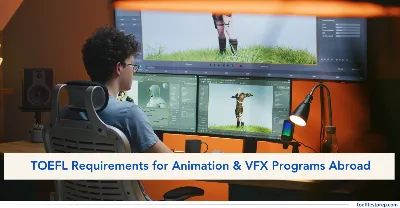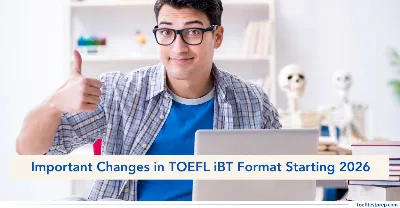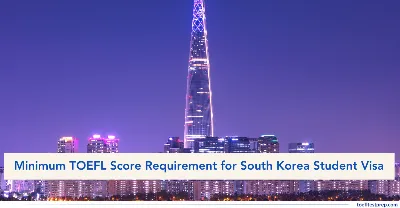TOEFL iBT® Requirements for Animation & VFX Programs Abroad

"Discover TOEFL score requirements for studying Animation and VFX abroad, and learn how to meet them for top creative universities."
Key Highlights
Animation and VFX are among the fastest-growing creative industries worldwide, and international students are increasingly looking to pursue specialized programs in this field. From blockbuster films to gaming and advertising, skilled animators and VFX professionals are in high demand. Countries like the United States, Canada, the United Kingdom, Australia, and South Korea are leading destinations for students who want to study Animation and VFX abroad.
To apply to these programs, international students need to demonstrate strong English language skills. The most widely accepted test is the TOEFL (Test of English as a Foreign Language). The minimum TOEFL iBT score for Animation and VFX programs abroad generally ranges from 70 to 100, depending on the country and university. Top-tier institutions may require higher scores, while others may accept more flexible ranges.
| Planning to study Animation and VFX overseas? Boost your scores with our online TOEFL Practice Test and get exam-ready today! |
TOEFL Accepting Universities for Animation & VFX Abroad
Here’s a list of popular universities that offer Animation and VFX programs abroad, along with their TOEFL requirements and country:
|
Country |
University |
TOEFL Score Requirement (iBT) |
|
United States |
Savannah College of Art and Design (SCAD) |
85–100 |
|
United States |
Ringling College of Art and Design |
79–90 |
|
Canada |
Sheridan College, Ontario |
80 |
|
Canada |
Vancouver Film School |
80–90 |
|
United Kingdom |
University of the Arts London |
72–90 |
|
United Kingdom |
Bournemouth University |
79–90 |
|
Australia |
RMIT University, Melbourne |
79–90 |
|
Australia |
Griffith University |
80 |
|
South Korea |
Korea National University of Arts |
75–85 |
|
Japan |
Tokyo University of the Arts |
80–90 |
Note: Requirements vary by program, and portfolios often carry significant weight in admission decisions.
General Admission Requirements for Animation & VFX Programs Abroad
Along with TOEFL scores, students applying for Animation and VFX courses must prepare a set of academic and creative documents. Typical admission requirements include:
|
Admission Requirement |
Description |
|
Valid Passport |
Should be valid for the duration of your studies abroad. |
|
Academic Qualifications |
High school diploma (for bachelor’s) or bachelor’s degree (for master’s). |
|
TOEFL Score |
Usually between 70–100 iBT depending on the country and institution. |
|
Portfolio |
A strong portfolio of your animation, design, or VFX work is often the most important requirement. |
|
Statement of Purpose (SOP) |
An essay highlighting your creative journey, academic goals, and career vision. |
|
Letters of Recommendation |
1–2 letters from teachers, professors, or employers. |
|
Academic Transcripts |
Official documents showing your grades and qualifications. |
|
Application Form |
University-specific online or paper form. |
|
Passport-sized Photos |
Required for records and visa application. |
|
Visa Requirements |
Admission letter, proof of funds, and health insurance for a student visa. |
Visa Requirements for Animation & VFX Programs Abroad
To pursue Animation and VFX programs abroad, students must apply for a student visa in the respective country. While requirements vary, here are some common ones:
- Valid passport with blank pages.
- Official admission letter from a recognized university or institute.
- Proof of English proficiency (TOEFL score report or equivalent).
- Bank statements or financial documents to show sufficient funds.
- Proof of accommodation arrangements.
- Health insurance valid in the study destination country.
- Completed visa application form and visa fee payment receipt.
- Recent passport-sized photographs.
For example, the United States requires an F-1 visa, Canada requires a study permit, and the UK requires a Tier 4 (Student) visa. Students must also attend a visa interview in most cases.
How to Apply to Animation & VFX Programs Abroad with TOEFL Score
Here’s a step-by-step guide for Indian students who want to apply:
1. Shortlist Universities Abroad: Look for universities in countries like the US, Canada, UK, Australia, or Asia that offer Animation and VFX programs and accept TOEFL.
2. Check TOEFL Requirements: Confirm the TOEFL iBT score requirement for your chosen university. Most require between 70 and 100.
3. Prepare a Strong Portfolio: Showcase your creative skills through animation projects, VFX work, illustrations, or short films.
4. Write a Statement of Purpose (SOP): Explain your passion for Animation and VFX, career goals, and why you want to study abroad.
5. Get Recommendation Letters: Request letters from professors or professionals familiar with your creative abilities.
6. Submit TOEFL Scores: Send your TOEFL iBT results directly through the ETS system to your shortlisted universities.
7. Complete the Application Form: Fill in all academic and personal details carefully and upload required documents.
8. Pay the Application Fee: Universities abroad usually charge a small, non-refundable fee.
9. Wait for Admission Decisions: Monitor your email and university portal for updates. Some schools may conduct interviews or portfolio reviews.
10. Apply for Student Visa: Once admitted, apply for the relevant student visa in your chosen country using your admission letter and financial documents.
Animation and VFX programs abroad open up exciting opportunities for creative students who want to make a mark in the global entertainment and media industry. Meeting the TOEFL requirements for Animation and VFX abroad is one of the first steps to securing admission. While the minimum TOEFL iBT score is typically 70–100, students should aim for higher scores to strengthen their applications, especially for top-ranked universities.
Along with TOEFL, your portfolio and creative skills play a crucial role in admission decisions. By preparing well for TOEFL, building an impressive portfolio, and following the right application process, you can turn your dream of studying Animation and VFX overseas into reality.
Also Read:
Featured Articles

TOEFL Format Undergoing Significant Changes in January 2026
The TOEFL iBT format is changing in January 2026 with a smarter structure and easier scoring. Here’s everything you need to know to stay ahead.
August 06, 2025
Minimum TOEFL Score Requirement for South Korea Student Visa
Understand the TOEFL requirement for a South Korea student visa and English-taught programs, and prepare your application for success.
September 14, 2025
Minimum TOEFL Score for Study Visa in Poland
Understand TOEFL score requirements for securing a Poland student visa and joining top universities offering English-taught programs.
September 14, 2025
TOEFL Requirements for Animation & VFX Programs Abroad
Discover TOEFL score requirements for studying Animation and VFX abroad, and learn how to meet them for top creative universities.
September 14, 2025